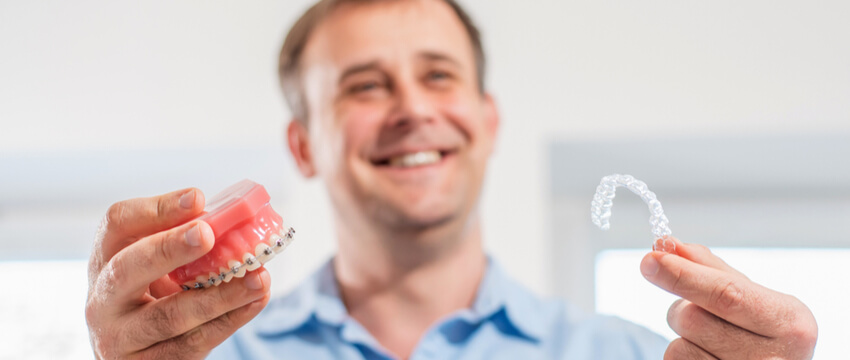Invisalign vs Braces – Which is Best For Your Smile?

Are you debating between Invisalign vs braces? Both have their pros and cons, and certain factors will make one a better fit than the other. While they both function to reach the same results: straighten your teeth, improve your oral health, and give you a more confident smile, there is a suitable option for you between these two. We are here to help you find out which one it is.
Basics of Invisalign vs braces
Before getting to their differences, we must first get an in-depth understanding of what these two are and how they work to give you your dream smile.
All about metal braces
Metal braces are the traditional orthodontic treatment that utilises metal brackets attached to the surface of the tooth. A wire then connects these across all the teeth.
How do metal braces work? The wire is tightened and manipulated to pull the tooth towards its ideal position. Your orthodontist will schedule appointments with you every 4-6 weeks to adjust the wire until the teeth are straightened. Braces are proven to be effective on even the most severe tooth malalignment because of the many ways in which your dentist can adjust the orthodontic wire to reach the desired results.
Invisalign treatment

Invisalign is a product of modern orthodontics and is an alternative to traditional braces. Its striking difference from metal braces is that Invisalign treatment does not require metal. Instead, it involves computerised technology and 3D engineering to produce custom-made, clear plastic trays that fit snugly on your teeth. The tight Invisalign fit helps with the gradual movement of teeth to their proper position.
Depending on the severity of your case, your dentist will prescribe a series of Invisalign clear aligners to you. You will need to change your aligner at least every ten days to expedite tooth movement and continue the process until your smile goal is reached.
The ultimate guide for Invisalign vs braces
Want to know about the Invisalign vs braces advantages and disadvantages, which has faster results, its treatment procedures, and the costs? Below, we have a complete comparison guide to both options, which can be of enormous help to you as you decide which to choose.
- Appearance – Metal braces are highly noticeable because of the presence of unsightly metals in brackets and wires. Meanwhile, Invisalign is virtually invisible!
- Oral health and hygiene – Braces are not removable, so special dental floss is required to remove food debris and clean in between the teeth. On the other hand, because Invisalign is removable, you can take out the aligner to clean it by brushing and rinsing in lukewarm water. At the same time, you can brush your teeth normally.
- Comfort level – Invisalign is regarded as being more comfortable because tooth movement is gradual. And there are no brackets and wires to contend with. But do metal braces always hurt? After adjustment, you may feel some discomfort because the wires will have been tightened, but this should dissipate over time.
- Dietary restrictions – Patients are advised to avoid eating hard and sticky food while undergoing treatment with traditional braces. Meanwhile, since Invisalign is removed when eating, there is no need to change your diet.
- Frequency of dental visits – Dental visits for metal braces are needed approximately every month. This is lessened for treatment with Invisalign, which only happens every 2-3 months. However, note that you must change your aligners every two weeks.
- Treatable cases – Invisalign can only treat specific issues. Meanwhile, all patients are treatable with traditional metal braces, including those with complex crossbites and severe deep bites.
- Patient compliance – Braces require minimal patient compliance because they are irremovable and worn 24/7. This makes them an excellent choice for kids. However, Invisalign aligners must be worn 20-22 hours daily. If not followed, it may result in relapse issues and longer treatment time.
- Treatment length – Braces can take 1-3 years on average, while Invisalign treatment is faster at 1-1.5 years. Both are dependent on case difficulty and patient compliance.
- Cost – Braces can cost considerably less than Invisalign.
The Invisalign vs. braces options for orthodontic treatment have their pros and cons. If you are still unsure which you would prefer, it’s always best to start with a chat with our experienced and highly qualified team at My Local Dentists. We will listen to your needs and requirements and suggest the most suitable treatment plan for you.
Ready to make your Invisalign vs braces decision? Whether you prefer your journey with traditional metal braces or Invisalign treatment, our ultimate goal is to give you a better smile. Contact us now at My Local Dentists for your initial consultation!
